Phosphates: Monazite
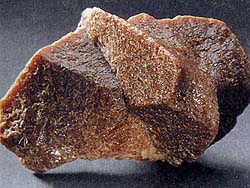 Diagnostic card.
Diagnostic card.
Ce PO 4
Singonia monoclinic
Hardness 5,5
Specific weight 4.8-5.5
Cleavage is easily manifested
Color is colorless, colored
Color in powder white
Shine from semi-diamond to glass
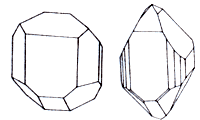
Monazite is a mineral of a rather complex composition: it can include some rare earth elements in small quantities (cerium, lanthanum, neodymium), as well as small amounts of praseodymium, samarium and gadolinium. There may also be uranium, thorium, calcium, sometimes in a noticeable amount. Monazite crystals have a variable appearance: they are thin, tabular or elongated along the vertical axis; But there are isometric and short-prismatic. Some crystals of monazite from granites and pegmatites reach a weight of several tens of kilograms (surrender to the state is mandatory). Surface faces are often irregular in shape and shaded. Visually, monazite often resembles anthracite coal when incorporated into granites and pegmatites.
Monazite, concentrated in the sands as a result of the destruction of primary monazite-bearing rocks, is often represented by grains. The color of the mineral is variable - from yellow to reddish brown and from light gray to greenish to black. Vary and shine of monazite from semi-diamond and glass to wax. The mineral is sometimes transparent or translucent, differs in hardness and heaviness, it is easily divided by cleavage.
Chemical composition. Volatile; Approximate composition: cerium oxide (Ce2O3) 26-31%, the sum of the oxides of lanthanum (La2O3), neodymium (Nd2O3), praseodymium (Pr2O3) 21-30%, yttrium oxide (Y2O3) 0.5-3.5%, thorium oxide (Th2O3) 1-28%, phosphorus pentoxide (P2O5) 22-31%, zirconia (ZrO2) up to 7%, silicon dioxide (SiO2) up to 6%, total content of cerium rare earths (in oxide form) 50-68% .
The shape of the crystals. Thick-tabulated, rarely prismatic small crystals interspersed with rocks (granite, syenite, diorite, gneiss); Sometimes monazite forms large crystals weighing up to several kilograms in pegmatites. Mineral is usually found in the form of separate grains interspersed with the rock. Class of symmetry. Prismatic - 2 / m. Cleavage. Sometimes perfect by (001), (100). Aggregates. Forms individual grains.
Diagnostic signs.
It has a weak radioactivity, is refractory and does not dissolve in water. It becomes gray when heated. Almost does not melt. Behavior in acids. With difficulty dissolves in HCl. The color is light yellow, dark brown, red, less often green. Do not engage in its diagnosis without using a special dosimeter !!
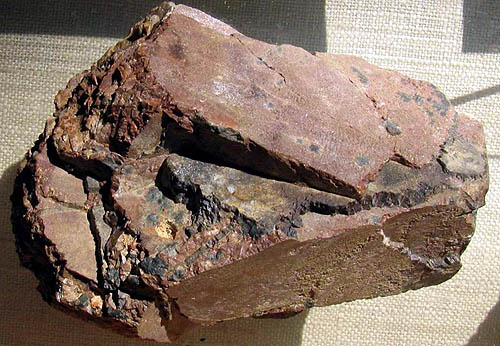
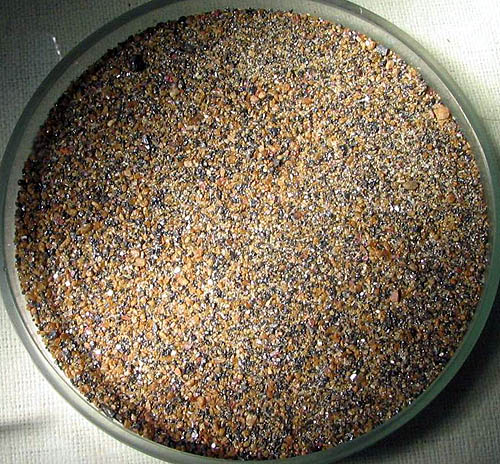
Origin.
Accessory mineral of granite and syenite rocks; Occurs in the form of distinct crystals in the pegmatites of these rocks. Monacitonic (monazite) sands (the so-called "Babylonian sands of time") are common in Brazil, India and Australia - radioactive , and therefore dangerous - their uncontrolled visit is prohibited (from 24-32 milli-roentgen / hour and above). These are not the usual deserts, no beaches and no place for walking.
Pay special attention to the monazite at the top of the page - it's not plaster (a visual similarity with the desert gypsum formations) !! Such solid monazite "roses of the desert" are imitators of gypsum and are very dangerous in home collections and in office exposures - they are found mainly not on the surface, but in the thickness of the sands of radioactive monazite deserts. Be vigilant - do not visit places with elevated background radiation (from 32 to 120 milli-radentgen / hour and above) uncontrollably, do not pick up any objects, stones and samples and do not take them out of places with a permanent elevated background of natural natural radiation (monazite deserts) !! !!
Place of Birth.
The best samples are from Norway and Madagascar, the states of Colorado and Wyoming. Small, but well-shaped transparent crystals of orange-yellow or pinkish-yellow color, appreciated by collectors, are present in alpine veins in many places. If you are not a fanatic working in specialized departments of state secretaries and museums, it is not recommended to collect this radioactive mineral - it is not stored at home.
Application.
Monaceton sands, common in Brazil, India and Australia, are used for industrial development to extract cerium and thorium. Keep in home, office and personal collections (including glass klepsidra) is strictly prohibited. Can occur in granites (inclusions visually reminiscent of anthracite) - monazite inclusions most often make granite radioactive - mandatory removal and delivery of radioactive monazite to the state of Ukraine (payable) is strictly required. The removal of granite with inclusions of monazite makes its surroundings safe from radiation (all granite is not removed).

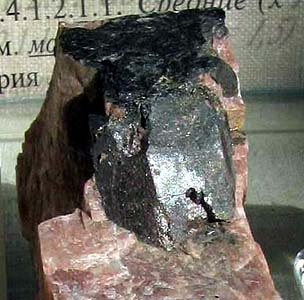
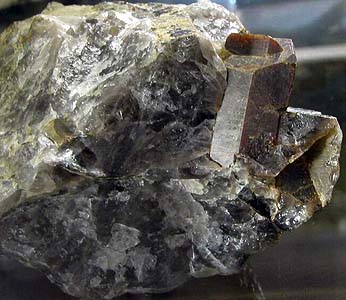
Monazite in the microcline. Lived Chkalov, Chupinskiy borough, Sev. Karelia, Russia.

Monazite. Ambatufucikeli, Madagascar. Photo: © А.А. Evseev.
ADR 7


Radioactive materials ( radiation , Ukraine)
Risk of absorption of external and internal radiation exposure
Limit impact time, radiation burns, radiation exposure of photographic and cinematographic materials
Yellow upper half of rhombus, white - lower, equal, ADR number, black sign of radiation, inscription
ADR 4.3


Substances that emit flammable gases in contact with water
Risk of fire and explosion if exposed to water.
The cargo, which crumbled, must be covered and kept dry
Blue and blue diamond, ADR number, black or white flame
ADR 4.1

Highly flammable solids , self-reactive substances and solid desensitized explosives
Risk of fire. Flammable or combustible substances can ignite from sparks or flames. May contain self-reactive substances capable of exothermic decomposition in the case of heating, contact with other substances (such as: acids, heavy metal compounds or amines), friction or impact.
This can lead to the emission of harmful or flammable gases or vapor or spontaneous combustion. Containers can explode when heated (over-dangerous - practically do not burn).
Risk of explosion of desensitized explosives after loss of desensitizer
Seven vertical red stripes on a white background, equal in number, ADR number, black flame
| The name of a cargo that is particularly dangerous for transportation | room
UN |
Class
ADR |
| CERIS - shavings or fine powder | 3078 | 4.3 |
| CERIUM plates, ingots or slivers | 1333 | 4.1 |
- Ghetchellit - "New Almaden blend" - arsenide and antimony sulfide (modern sulfosol)
- Antimony is a toxic metal (semimetal) , widely used in metallurgy, medicine and engineering
- Zirconium - a rare and undiscovered metal and the most dangerous precious stone in oxide and salt
- Gold - yellow dangerous and poisonous metal of modern accurate digital and cable technologies
- Sulfur is a golden-yellow toxic substance and a sign of active volcanic activity
- Cadmium is an undisputed toxic silvery metal unknown to a wide range of people
- Lead - a toxic gray imitator of metallic silver and toxic metal blende
- Arsenic is a classic poison of medieval and modern poisoners and medicine in medicine
Poisonous and radioactive dangerous stones and minerals
** - poisonous stones and minerals (mandatory check in the chemical laboratory + explicit indication of toxicity)
** - radioactive stones and minerals (mandatory check on the standard dosimeter + ban on open sales in case of radioactivity exceeding 24 milli / g / h + additional measures of population protection)
Catalog of minerals and semi-precious stones of the world by groups
** - poisonous stones and minerals
** - radioactive stones and minerals


Comments
When commenting on, remember that the content and tone of your message can hurt the feelings of real people, show respect and tolerance to your interlocutors even if you do not share their opinion, your behavior in the conditions of freedom of expression and anonymity provided by the Internet, changes Not only virtual, but also the real world. All comments are hidden from the index, spam is controlled.